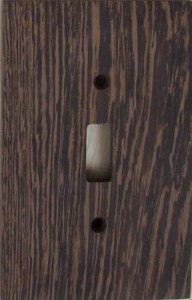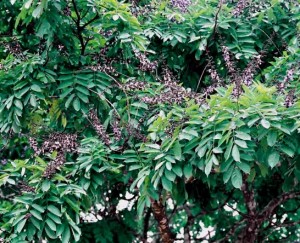I would have come up with about a thousand uses for Wenge before coming across this switchplate. This, and many other species are available at C&R Woodcrafters.
Trade Name: Wenge.
Kingdom: Plantae
(unranked): Angiosperms
(unranked): Eudicots
(unranked): Rosids
Order: Fabales
Family: Fabaceae
Subfamily: Faboideae
Tribe: Millettieae
Genus: Millettia
Species: M. laurentii
Janka Hardness (pounds-force): 2240
Description: Deep brown and figured with contrasting grain of a nearly black color. Generally straight grained and coarsely textured. Very large pores, so a perfectly smooth surface will be somewhat more difficult to achieve than with many species.
Location: Central Africa, namely: Cameroon, Zaire, Tanzania, Congo, Gabon, Mozambique.
Common Aliases: Anong, Awoung, Bokonge, Bwengu, Dikela, Mboto, Mibotu, Monkonge, N’gondou, N’toka, N’toko, Nsou-so, Otogo, Palissandre du congo, Tshikalakala, Zai-wenge
Performance: Wenge blunts tools fairly regularly, and sanding can be a chore due to the great difference in density between the rings. Wenge splinters easily, and take care, as these are more than likely to cause a septic reaction. Large diffuse pores with random distribution throughout the lumber. Wenge is very durable, and measures up quite well with many other highly desired tropical hardwoods for outdoor application.
Affordability: $$$$ Wenge is right up there with some of the most expensive species on the market.
A nice shot of the Millettia laurentii, from which Wenge is derived, in flower.
Common Uses: Wenge is generally a specialty wood used in many different applications such as: Flooring, paneling, furniture, arts and crafts, carvings, turnings, organ pipes, pianos, plywood, veneer, and etc.
From: The Wood Database:
Common Name(s): Wenge
Scientific Name: Millettia laurentii
Distribution: Africa (Cameroon, Congo, Gabon, Mozambique, Tanzania, Zaire)
Tree Size: 60-90 ft (18-27 m) tall, 3-4 ft (1-1.2 m) trunk diameter
Average Dried Weight: 57 lbs/ft3 (910 kg/m3)
Basic Specific Gravity: .74
Hardness: 2,240 lbf (9,940 N)
Rupture Strength: 22,020 lbf/in2 (151,900 kPa)
Elastic Strength: 2,379,000 lbf/in2 (16,400 MPa)
Crushing Strength: 11,910 lbf/in2 (82.1 MPa)
Shrinkage: Radial: 3.1%, Tangential: 5.8%, Volumetric: 8.9%, T/R Ratio: 1.9

